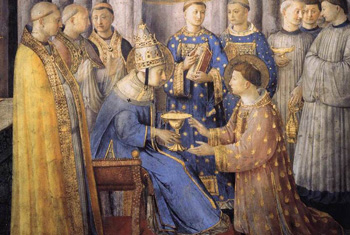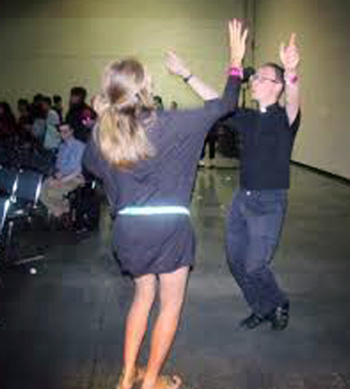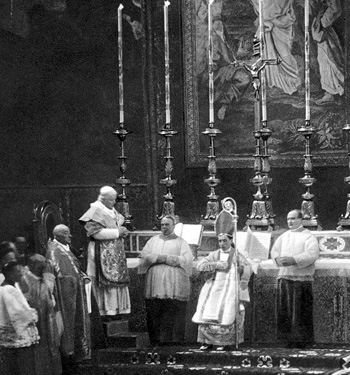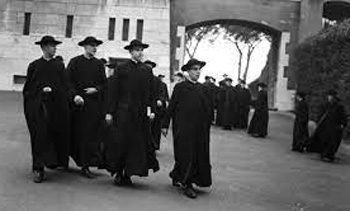Problemas Tradicionalistas
 |
 |
 |
 |
 |
 |
 |
Misa de diálogo - CXII
La Perfección del Clero
Ahora llegamos al tercer y más importante factor de las Órdenes Menores aclarado por el P. Bacuez – la perfección de los que entraron en el estado clerical desde el momento en que recibieron la Primera Tonsura – aunque no todos los candidatos procedieran al destino final del sacerdocio.
 Esto requería que se separaran de los fieles ordinarios y de las influencias mundanas para entregarse a las cosas del Cielo, lo contrario de los objetivos del Vaticano II, que pregonaba la igualdad con los laicos y la apertura al mundo.
Esto requería que se separaran de los fieles ordinarios y de las influencias mundanas para entregarse a las cosas del Cielo, lo contrario de los objetivos del Vaticano II, que pregonaba la igualdad con los laicos y la apertura al mundo.
Durante siglos antes del Concilio Vaticano II, la Iglesia enseñó constantemente a través de numerosos santos, doctores y papas que se requería un mayor grado de perfección, y una carga de responsabilidad correspondientemente mayor ante Dios, para aquellos en todos los grados de órdenes clericales. Por lo tanto, se desarrolló a partir del siglo III (1) un patrón de ordenaciones secuenciales, el cursus honorum, que finalmente se estandarizó como la forma habitual en que la Iglesia mejor podría seleccionar, preparar, probar y promover candidatos dignos a un puesto más alto.
El objetivo que se buscaba en este proceso era la perfección del clero en todas las etapas de su carrera eclesiástica, incluso de aquellos que no completaron el cursus completo.
Seamos claros
Es una situación familiar en la política del Vaticano II que cada vez que los progresistas introdujeron cambios contra-tradicionales, envolvieron sus explicaciones en vaguedad, evasivas y engaños. Eso está claro ahora. Pero allá por 1972, pocos habrían notado las señales de engaño en el Ministeria quaedam de Pablo VI mediante las cuales suprimió las Órdenes Menores.
 Porque, para justificar la conversión de las Órdenes Menores en ministerios laicos, tenía que evitar dar la impresión de que los ministerios litúrgicos de los primeros cristianos eran de naturaleza clerical, es decir, conferidos en ritos de ordenación por un obispo . En el documento, Pablo VI, usando términos genéricos, afirmó que estaban “encomendados a los fieles” en “un rito especial” que involucraba oraciones por “la bendición de Dios”.
Porque, para justificar la conversión de las Órdenes Menores en ministerios laicos, tenía que evitar dar la impresión de que los ministerios litúrgicos de los primeros cristianos eran de naturaleza clerical, es decir, conferidos en ritos de ordenación por un obispo . En el documento, Pablo VI, usando términos genéricos, afirmó que estaban “encomendados a los fieles” en “un rito especial” que involucraba oraciones por “la bendición de Dios”.
No dio ninguna indicación de que los fieles a quienes se confiaban los ministerios litúrgicos se constituyeran primero como clérigos, es decir, hombres ordenados por un obispo para desempeñar esos roles. La evidencia más antigua de esto proviene de los escritos de los Padres de la Iglesia en la era post-apostólica. El obispo del siglo III, San Cipriano, por ejemplo, menciona en la Epístola 32 que cuando promovió a Aurelio como Lector, fue uno de varios grados de "ordenación clerical".
Un catalizador para la revolución
La tergiversación de Pablo VI sobre este tema prestó así apoyo a los reformadores que habían creado y difundido la falsa noción de que, en los primeros siglos del cristianismo, el clero no tenía derechos exclusivos para ejercer los ministerios litúrgicos, ya que estos pertenecían a hombres y mujeres laicos. El corolario de este argumento era que a los laicos se les debería restaurar la justicia con reconocimiento oficial en un rito de “institución” – de ahí el tenor revolucionario de Ministeria quaedam.
Este mal espíritu de descontento había sido identificado y condenado por el Papa Pío X quien defendía la doctrina de que la Iglesia era, por naturaleza, una sociedad desigual compuesta por la Jerarquía y el resto de los fieles, (2) gobernantes y gobernados.
No es sorprendente que la “igualdad” fuera una de las consignas tanto de la Revolución Francesa como de la Revolución Bolchevique; y que el Card. Suenens y el P. Yves Congar identificaran en su momento, el Vaticano II con estas revoluciones anticatólicas.
Una supresión perjudicial para el sacerdocio
Lo que surge muy claramente de la historia de las Órdenes Menores es que fueron instituidas para la perfección del clero, como el P. Bacuez explicó:
 “Cada ordenación sucesiva requiere marcas adicionales de dignidad en los candidatos, al mismo tiempo que les confiere gracias adicionales. Así, cada ordenación proporciona un doble medio para el progreso en la virtud. Por tanto, el seminario es un camino cuyo fin es la perfección y por el que la gracia divina les hace avanzar casi necesariamente». (3)
“Cada ordenación sucesiva requiere marcas adicionales de dignidad en los candidatos, al mismo tiempo que les confiere gracias adicionales. Así, cada ordenación proporciona un doble medio para el progreso en la virtud. Por tanto, el seminario es un camino cuyo fin es la perfección y por el que la gracia divina les hace avanzar casi necesariamente». (3)
Este sistema inmemorial de ritos de ordenación secuencial y gracias acumulativas, que había sido provisto por la Iglesia para un ministerio fructífero en el estado clerical, fue brutalmente terminado por Pablo VI en 1972. Uno de los pretextos dados en Ministeria quaedam para su supresión, fue que no todos los destinatarios de las órdenes menores pasaban a ser diáconos o sacerdotes.
Por lo tanto, se concluyó, por un obvio non sequitur, que todos los que no estuvieran en las Órdenes Mayores de ahora en adelante tendrían que ser simplemente miembros del laicado.
Pero en el sistema tradicional, incluso cuando un clérigo en particular no completaba todos los grados que conducen al sacerdocio, todavía estaba en posesión de los poderes y gracias que le confería su ordenación para el cumplimiento de sus deberes. Y, salvo que fuera destituido de su cargo o solicitado permiso para volver al estado laico, continuaba manteniendo su vínculo con la cadena de cargos que se relacionan con la Jerarquía.
El estatus especial de los clérigos menores
Era de conocimiento común entre los fieles anteriores al Vaticano II que todos los miembros del clero eran elevados a una posición preeminente en la Iglesia y la sociedad. (Eso, por supuesto, fue antes de que la “participación activa” de los laicos distorsionara la venerable y arraigada tradición del ministerio litúrgico como coto privado del clero).
 En los albores del Movimiento Litúrgico, el P. Bacuez describió las Órdenes Menores así: (4)
En los albores del Movimiento Litúrgico, el P. Bacuez describió las Órdenes Menores así: (4)
“Las Órdenes Menores están muy por encima no solo de todas las dignidades terrenales, sino también del ministerio levítico e incluso de las misiones de aquellos hombres extraordinarios que Dios levantó en diversos momentos para la guía, protección o reforma de Su pueblo, Israel”.
Como la dignidad del sacerdote deriva principalmente de su poder sobrenatural para realizar la Eucaristía y perdonar los pecados, se sigue lógicamente que aquellos que recibieron las órdenes menores participan, aunque sea mínimamente, del resplandor reflejado del sacerdote. Padre Bacuez da la razón de esto:
“Aquel que es investido con estas primeras Órdenes comienza a tener una participación en los poderes del gran Sumo Sacerdote”. (5)
Debemos notar el uso de la palabra “comienza”: significa que el hombre ordenado en las Órdenes Menores ha sido promovido a una posición que no podría haber tenido como laico, una posición que realmente le da derecho, por la primera vez en su vida, para participar en algunos de los poderes litúrgicos del sacerdocio de Cristo.
Como era tradición establecida y universal que sólo un clérigo, ya sea en órdenes menores o mayores, puede desempeñar adecuadamente un papel hierático distinto en el santuario como resultado de la Ordenación, se sigue que debe seguir un camino de perfección espiritual superior. El Concilio de Trento declaró:
 “Nada instruye mejor a los demás en la piedad y el culto a Dios que la vida y el ejemplo de quienes se dedican al ministerio divino. ... A ellos, como a un espejo, otros dirigen su mirada, y en ellos encuentran fuente de imitación. Es muy conveniente, pues, que los clérigos llamados al servicio de Dios orienten su vida y sus hábitos, de modo que en el vestido, el gesto, el andar, la palabra y en todo lo demás no muestren sino lo serio, moderado y religioso”.
“Nada instruye mejor a los demás en la piedad y el culto a Dios que la vida y el ejemplo de quienes se dedican al ministerio divino. ... A ellos, como a un espejo, otros dirigen su mirada, y en ellos encuentran fuente de imitación. Es muy conveniente, pues, que los clérigos llamados al servicio de Dios orienten su vida y sus hábitos, de modo que en el vestido, el gesto, el andar, la palabra y en todo lo demás no muestren sino lo serio, moderado y religioso”.
El fundamento de la enseñanza tradicional fue explicado por el P. Bácuez:
“La gloria de Dios y la santificación de las almas exigen que el ministro sagrado sea tanto más inmaculado, más santo, más ferviente en cuanto que sus relaciones con la santidad misma son más estrechas e íntimas”. (6)
Pero la necesidad de esta perfección adquirida ya no es obvia hoy en la Iglesia posterior al Concilio Vaticano II, donde la distinción entre lo sagrado y lo profano ha sido deliberadamente borrada, donde se han quitado las barandillas del altar que delimitan el lugar del Lugar Santísimo y donde los laicos tienen acceso desinhibido al santuario.
Continuará...

La ordenación de San Lorenzo como Diácono
Durante siglos antes del Concilio Vaticano II, la Iglesia enseñó constantemente a través de numerosos santos, doctores y papas que se requería un mayor grado de perfección, y una carga de responsabilidad correspondientemente mayor ante Dios, para aquellos en todos los grados de órdenes clericales. Por lo tanto, se desarrolló a partir del siglo III (1) un patrón de ordenaciones secuenciales, el cursus honorum, que finalmente se estandarizó como la forma habitual en que la Iglesia mejor podría seleccionar, preparar, probar y promover candidatos dignos a un puesto más alto.
El objetivo que se buscaba en este proceso era la perfección del clero en todas las etapas de su carrera eclesiástica, incluso de aquellos que no completaron el cursus completo.
Seamos claros
Es una situación familiar en la política del Vaticano II que cada vez que los progresistas introdujeron cambios contra-tradicionales, envolvieron sus explicaciones en vaguedad, evasivas y engaños. Eso está claro ahora. Pero allá por 1972, pocos habrían notado las señales de engaño en el Ministeria quaedam de Pablo VI mediante las cuales suprimió las Órdenes Menores.

Un sacerdote 'conservador' del Vaticano II dirige a las porristas en un ensayo de rutina
No dio ninguna indicación de que los fieles a quienes se confiaban los ministerios litúrgicos se constituyeran primero como clérigos, es decir, hombres ordenados por un obispo para desempeñar esos roles. La evidencia más antigua de esto proviene de los escritos de los Padres de la Iglesia en la era post-apostólica. El obispo del siglo III, San Cipriano, por ejemplo, menciona en la Epístola 32 que cuando promovió a Aurelio como Lector, fue uno de varios grados de "ordenación clerical".
Un catalizador para la revolución
La tergiversación de Pablo VI sobre este tema prestó así apoyo a los reformadores que habían creado y difundido la falsa noción de que, en los primeros siglos del cristianismo, el clero no tenía derechos exclusivos para ejercer los ministerios litúrgicos, ya que estos pertenecían a hombres y mujeres laicos. El corolario de este argumento era que a los laicos se les debería restaurar la justicia con reconocimiento oficial en un rito de “institución” – de ahí el tenor revolucionario de Ministeria quaedam.
Este mal espíritu de descontento había sido identificado y condenado por el Papa Pío X quien defendía la doctrina de que la Iglesia era, por naturaleza, una sociedad desigual compuesta por la Jerarquía y el resto de los fieles, (2) gobernantes y gobernados.
No es sorprendente que la “igualdad” fuera una de las consignas tanto de la Revolución Francesa como de la Revolución Bolchevique; y que el Card. Suenens y el P. Yves Congar identificaran en su momento, el Vaticano II con estas revoluciones anticatólicas.
Una supresión perjudicial para el sacerdocio
Lo que surge muy claramente de la historia de las Órdenes Menores es que fueron instituidas para la perfección del clero, como el P. Bacuez explicó:

Un sacerdote, ahora igual a los laicos, baila en una iglesia
Este sistema inmemorial de ritos de ordenación secuencial y gracias acumulativas, que había sido provisto por la Iglesia para un ministerio fructífero en el estado clerical, fue brutalmente terminado por Pablo VI en 1972. Uno de los pretextos dados en Ministeria quaedam para su supresión, fue que no todos los destinatarios de las órdenes menores pasaban a ser diáconos o sacerdotes.
Por lo tanto, se concluyó, por un obvio non sequitur, que todos los que no estuvieran en las Órdenes Mayores de ahora en adelante tendrían que ser simplemente miembros del laicado.
Pero en el sistema tradicional, incluso cuando un clérigo en particular no completaba todos los grados que conducen al sacerdocio, todavía estaba en posesión de los poderes y gracias que le confería su ordenación para el cumplimiento de sus deberes. Y, salvo que fuera destituido de su cargo o solicitado permiso para volver al estado laico, continuaba manteniendo su vínculo con la cadena de cargos que se relacionan con la Jerarquía.
El estatus especial de los clérigos menores
Era de conocimiento común entre los fieles anteriores al Vaticano II que todos los miembros del clero eran elevados a una posición preeminente en la Iglesia y la sociedad. (Eso, por supuesto, fue antes de que la “participación activa” de los laicos distorsionara la venerable y arraigada tradición del ministerio litúrgico como coto privado del clero).

San Pío X confiere el cardenalato al futuro Benedicto XV en la solemne ceremonia del pasado
“Las Órdenes Menores están muy por encima no solo de todas las dignidades terrenales, sino también del ministerio levítico e incluso de las misiones de aquellos hombres extraordinarios que Dios levantó en diversos momentos para la guía, protección o reforma de Su pueblo, Israel”.
Como la dignidad del sacerdote deriva principalmente de su poder sobrenatural para realizar la Eucaristía y perdonar los pecados, se sigue lógicamente que aquellos que recibieron las órdenes menores participan, aunque sea mínimamente, del resplandor reflejado del sacerdote. Padre Bacuez da la razón de esto:
“Aquel que es investido con estas primeras Órdenes comienza a tener una participación en los poderes del gran Sumo Sacerdote”. (5)
Debemos notar el uso de la palabra “comienza”: significa que el hombre ordenado en las Órdenes Menores ha sido promovido a una posición que no podría haber tenido como laico, una posición que realmente le da derecho, por la primera vez en su vida, para participar en algunos de los poderes litúrgicos del sacerdocio de Cristo.
Como era tradición establecida y universal que sólo un clérigo, ya sea en órdenes menores o mayores, puede desempeñar adecuadamente un papel hierático distinto en el santuario como resultado de la Ordenación, se sigue que debe seguir un camino de perfección espiritual superior. El Concilio de Trento declaró:

Los sacerdotes deben permanecer separados de los laicos
para su propia perfección
El fundamento de la enseñanza tradicional fue explicado por el P. Bácuez:
“La gloria de Dios y la santificación de las almas exigen que el ministro sagrado sea tanto más inmaculado, más santo, más ferviente en cuanto que sus relaciones con la santidad misma son más estrechas e íntimas”. (6)
Pero la necesidad de esta perfección adquirida ya no es obvia hoy en la Iglesia posterior al Concilio Vaticano II, donde la distinción entre lo sagrado y lo profano ha sido deliberadamente borrada, donde se han quitado las barandillas del altar que delimitan el lugar del Lugar Santísimo y donde los laicos tienen acceso desinhibido al santuario.
Continuará...
- San Cipriano de Cartago (quien murió en 258) en su Epístola 51 afirmó, con referencia al Papa Cornelio, quien se convirtió en obispo de Roma en 251, que “él no fue alguien que de repente alcanzó el episcopado pero, promovido a través de todos los oficios eclesiásticos... ascendió por todos los grados del servicio religioso a la alta cumbre del sacerdocio”.
- Pius X, Vehementer nos, 1906, §8.
- Louis Bacuez SS, Minor Orders, St Louis MO: B. Herder, 1912, p. 136.
- Ibid., p. 158.
- Ibid., p. 160.
- Ibid., p. 145.
Publicado el 8 de febrero de 2022
______________________
______________________
 Volume I |
 Volume II |
 Volume III |
 Volume IV |
 Volume V |
 Volume VI |
 Volume VII |
 Volume VIII |
 Volume IX |
 Volume X |
 Volume XI |
 Special Edition |



